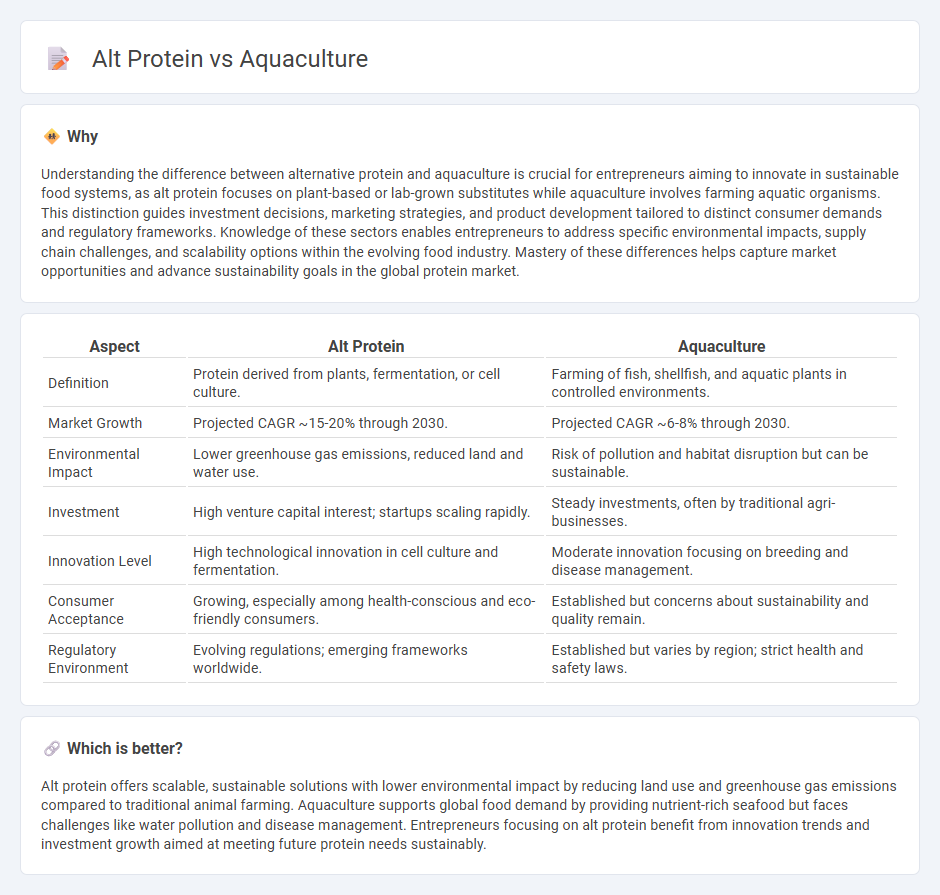
Entrepreneurship in alternative protein and aquaculture sectors addresses the rising demand for sustainable food sources amid global population growth and environmental concerns. Innovators focus on developing plant-based, cultured, and fermentation-derived proteins alongside advanced aquaculture practices to reduce ecological impact and enhance food security. Explore how these transformative industries are reshaping the future of nutrition and investment opportunities.
Why it is important
Understanding the difference between alternative protein and aquaculture is crucial for entrepreneurs aiming to innovate in sustainable food systems, as alt protein focuses on plant-based or lab-grown substitutes while aquaculture involves farming aquatic organisms. This distinction guides investment decisions, marketing strategies, and product development tailored to distinct consumer demands and regulatory frameworks. Knowledge of these sectors enables entrepreneurs to address specific environmental impacts, supply chain challenges, and scalability options within the evolving food industry. Mastery of these differences helps capture market opportunities and advance sustainability goals in the global protein market.
Comparison Table
| Aspect | Alt Protein | Aquaculture |
|---|---|---|
| Definition | Protein derived from plants, fermentation, or cell culture. | Farming of fish, shellfish, and aquatic plants in controlled environments. |
| Market Growth | Projected CAGR ~15-20% through 2030. | Projected CAGR ~6-8% through 2030. |
| Environmental Impact | Lower greenhouse gas emissions, reduced land and water use. | Risk of pollution and habitat disruption but can be sustainable. |
| Investment | High venture capital interest; startups scaling rapidly. | Steady investments, often by traditional agri-businesses. |
| Innovation Level | High technological innovation in cell culture and fermentation. | Moderate innovation focusing on breeding and disease management. |
| Consumer Acceptance | Growing, especially among health-conscious and eco-friendly consumers. | Established but concerns about sustainability and quality remain. |
| Regulatory Environment | Evolving regulations; emerging frameworks worldwide. | Established but varies by region; strict health and safety laws. |
Which is better?
Alt protein offers scalable, sustainable solutions with lower environmental impact by reducing land use and greenhouse gas emissions compared to traditional animal farming. Aquaculture supports global food demand by providing nutrient-rich seafood but faces challenges like water pollution and disease management. Entrepreneurs focusing on alt protein benefit from innovation trends and investment growth aimed at meeting future protein needs sustainably.
Connection
Alt protein and aquaculture intersect through the development of sustainable seafood alternatives, reducing reliance on traditional fish farming and wild catch. Innovations in cellular aquaculture use cultivated fish cells to produce protein-rich products with lower environmental impact. This synergy promotes eco-friendly entrepreneurship by addressing global food security and ocean conservation challenges.
Key Terms
Value Proposition
Aquaculture offers a sustainable approach to seafood production with high nutrient density, supporting global food security through efficient resource usage and reduced environmental impact. Alternative proteins, including plant-based and cellular options, emphasize scalability, reduced carbon footprints, and animal welfare benefits, targeting health-conscious consumers and innovation-driven markets. Explore the distinct value propositions of aquaculture and alternative proteins to understand their roles in the future of sustainable food.
Supply Chain
Aquaculture relies on established supply chains that integrate fish farms, feed production, processing, and distribution to ensure seafood availability worldwide. Alternative proteins depend heavily on innovative supply chains involving raw material sourcing, bioprocessing facilities, and cold chain logistics to maintain product integrity from lab to table. Explore how supply chain dynamics influence scalability and sustainability in these protein sectors.
Market Differentiation
Aquaculture leverages sustainable fish farming techniques to meet growing seafood demand, while alternative proteins focus on plant-based, cell-cultured, or fermentation-derived options to reduce environmental impact and diversify protein sources. Market differentiation lies in aquaculture's emphasis on replicating natural marine ecosystems and enhancing product traceability, whereas alternative proteins highlight innovation, scalability, and consumer health benefits. Explore comprehensive insights on how these sectors uniquely position themselves to transform the future of global protein supply.
Source and External Links
Aquaculture - Woods Hole Oceanographic Institution - Aquaculture is the farming of aquatic animals and plants mainly for food, including fish, mollusks, crustaceans, and seaweeds, with a history dating back 4,000 years and now supplying over half of the seafood consumed globally.
Aquaculture - Wikipedia - Aquaculture encompasses farming fish, mollusks, crustaceans, and plants in controlled environments such as tanks, ponds, or ocean enclosures, with species like carp, salmon, tilapia, and catfish being the most commonly farmed.
What is aquaculture? - NOAA's National Ocean Service - Aquaculture is the breeding, rearing, and harvesting of fish, shellfish, algae, and other organisms in freshwater and marine environments, serving to produce food, restore habitats, replenish wild stocks, and support sustainable seafood production.
 dowidth.com
dowidth.com